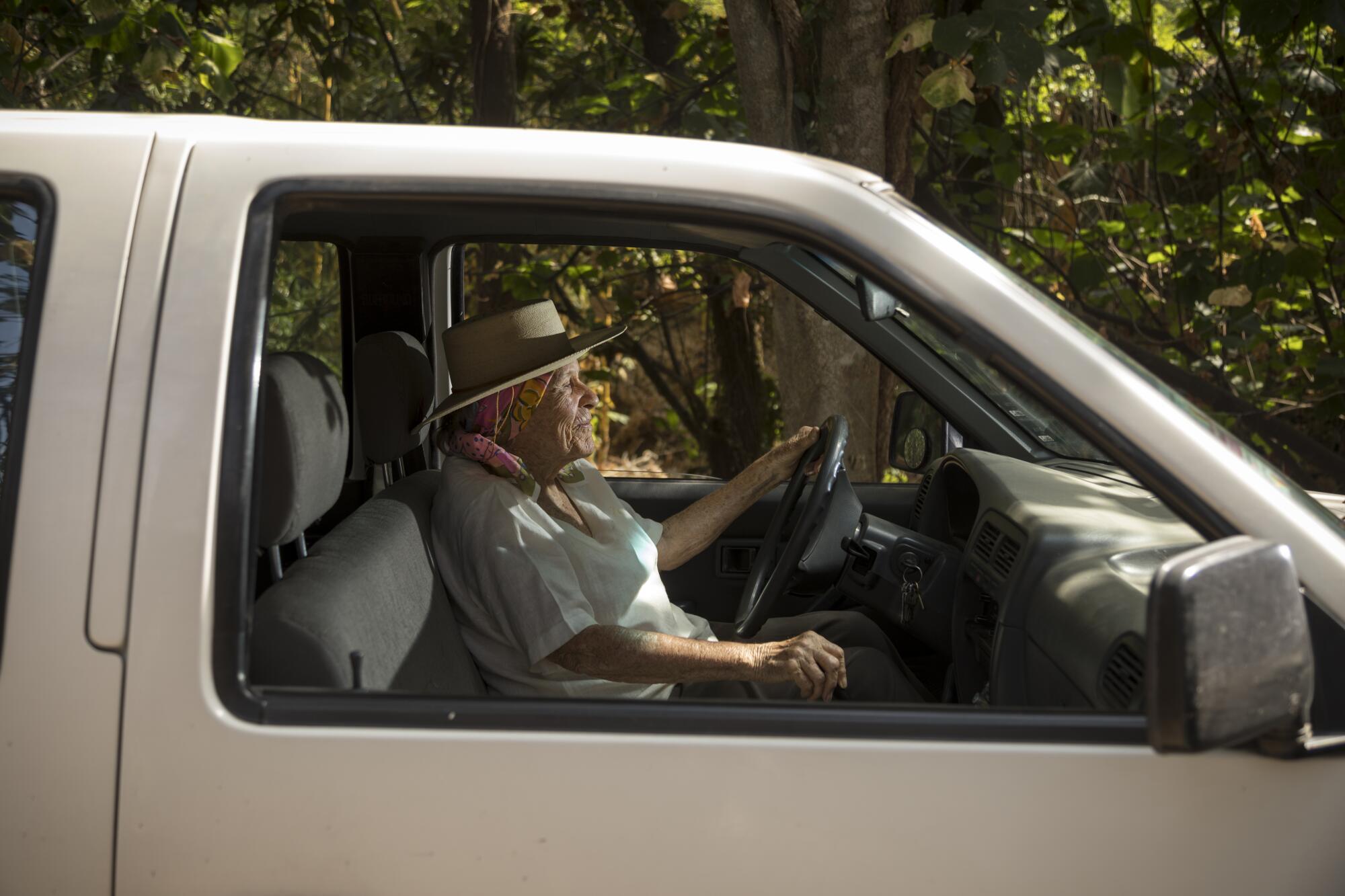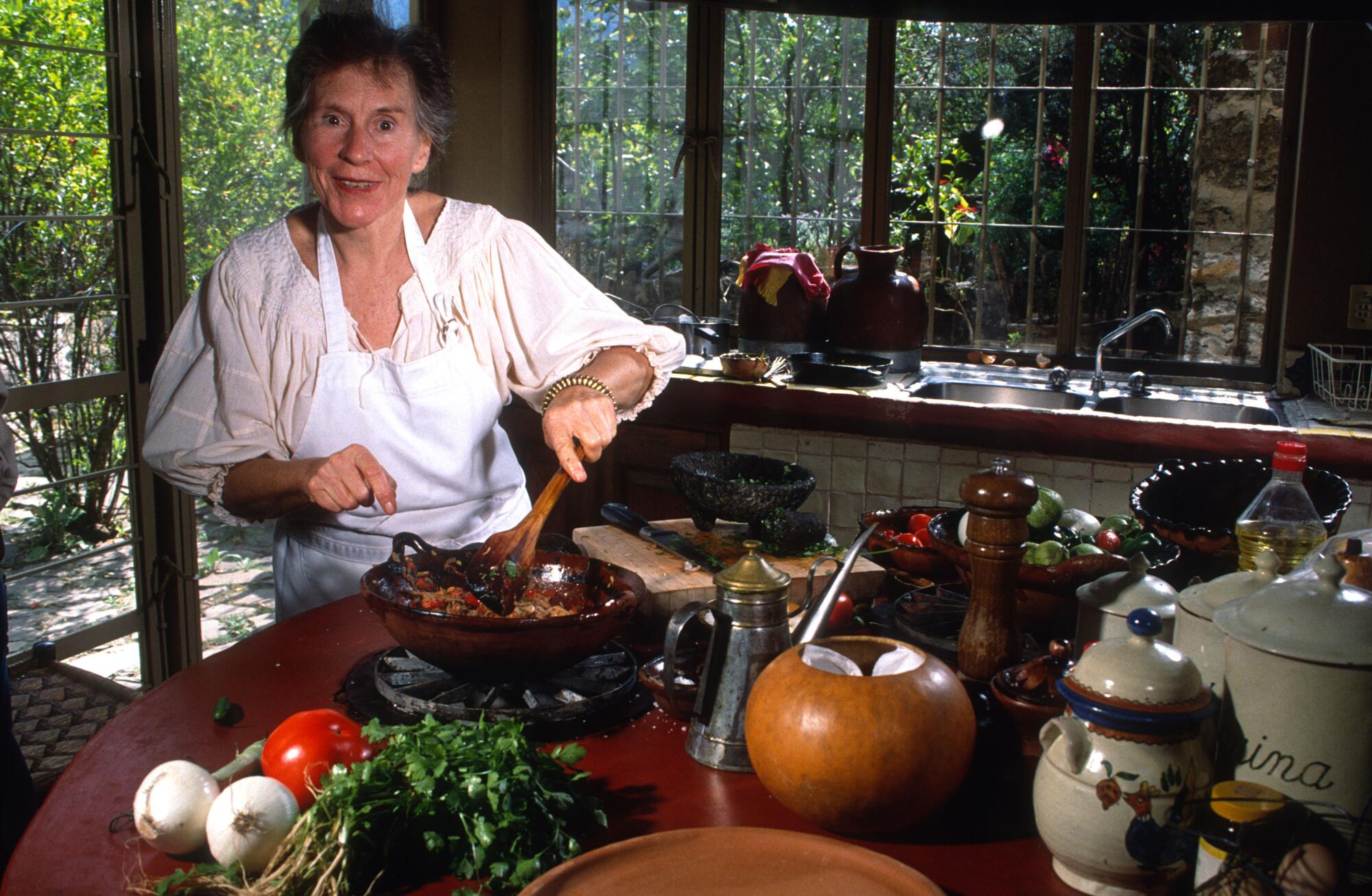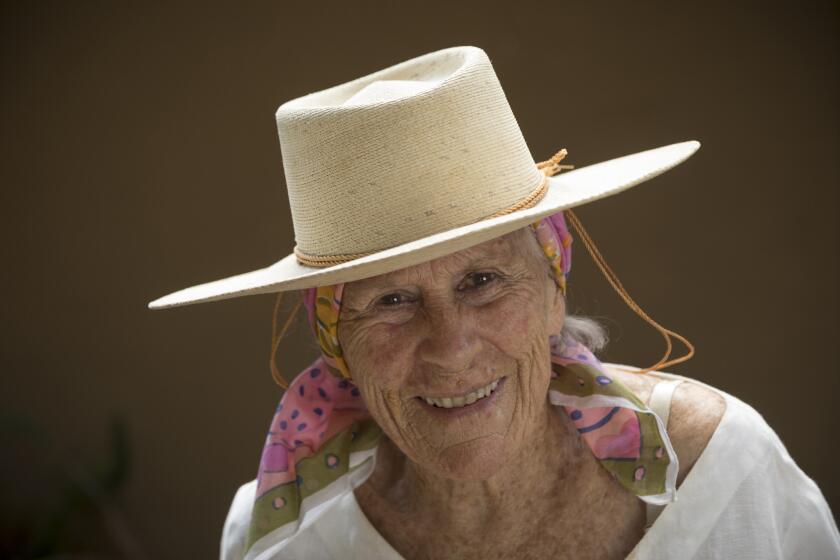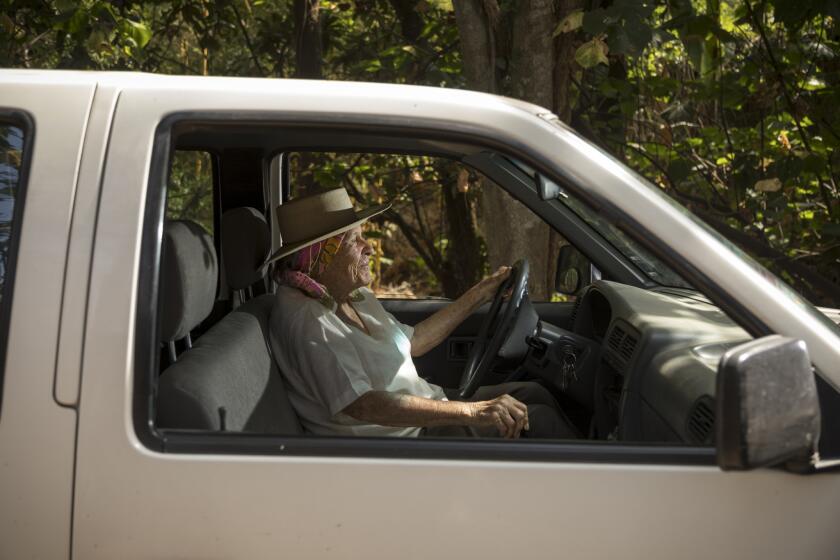- Share via
The house seems to grow out of the rocks and trees it’s set against, with a gargantuan boulder lodged into its center, anchoring the staircase to the second level. Kitchen counters and nooks are layered with hanging pots, pottery and various bottled legumes, spices and vinegars made from banana, pineapple, red wine and pulque.
Outside, fruit trees, pines and fronds of every sort seem to engulf the available sunlight. I spot stables down a ramble. Rounded, built-in stone ovens preside over the patio, as well as a modern solar oven, like a blinding silver flower, where a pot of beans sits bubbling.
This is how I remember the home of Diana Kennedy, who died there Sunday of respiratory failure at age 99. Nestled into the hilly countryside of Michoacán state, in the town of Coatepec de Morelos on the edge of the central highlands of Mexico, the house known as Quinta Diana was home base for the British-born cook for five decades as she diligently pursued a full-spectrum documentation of traditional recipes across every region of Mexico.
The woman moved through life in such a way that you could trick your brain into assuming she would live forever. I’d like to think her entrance to the afterlife occurred just as she damn well pleased it would.
Testy and uncompromising, she drove her truck across Mexico for decades, collecting and preserving regional ingredients and recipes.
I had one afternoon with Kennedy at Quinta Diana in spring 2014, and I had so many questions. I also sort of expected, comically, some kind of bountiful feast prepared for her journalist guest from Vice magazine. However, Kennedy, 91 at the time, was done with being a “good” host; she announced early on that we’d be eating nothing more than maybe a tamal veracruzano or some candied duraznos (peaches) she’d just finished.
That day I learned that, more than anything else, Diana Kennedy was angry.
She hated all the plastic. She told me she reused, over and over, every plastic bag or container she’d ever been given.
She was mad at all the wasted water in Mexico’s industries.
She hated pesticides.
She scorned industrialized tortillas.
And she truly hated, despised, the fact that Mexico was importing corn from the United States. Imported corn! In Mexico! Where corn, one of the planet’s greatest gifts to mankind, was born!
This fact, to Kennedy, seemed to encapsulate everything that was wrong with everything. And because of it, she expressed anger at the world of food itself — the corporatizing, the genetic modifications and unfettered, market-driven globalization that had pushed the world at large, she argued, to literally lose its taste. “Especially in the U.S.,” she told me. “And then it passes to Mexico.”
“Why is it that we have allowed people who are totally incompetent in food to design our food?” she said that day in her unapologetic British accent. “Our food doesn’t have the flavor it used to have. I remember the chile poblanos, full of flavor, thin-fleshed, very dark green, and that big. Now ¡olvidalo!”
Forget it.
“I was in Oaxaca in 1964, when it was just … lost,” Kennedy whistled, dipping into memories of a place not saturated with tourists from the United States, Canada and Europe, as it is now. “It was gorgeous, oh, not all that awful noise of traffic. It was just beautiful.”
Kennedy arrived in Mexico in the 1950s as spouse to a correspondent for the New York Times and fell in love with the country and the depth of its cultures. A totally Indigenous culinary geography in every state, despite colonization, seemed to bloom before her; markets teemed with countless varieties of corn and chiles; and recipes, she’d quickly learn, for staple dishes like tamales or moles varied wildly not only from state to state, but village to village. After her husband, Paul Kennedy, died in New York in 1967, Diana Kennedy decided to resettle in Mexico permanently.
She got in her truck and started driving. Little by little, she traversed the country on her own, defying norms about foreigners — and foreign women — traveling to non-touristy destinations in a country with weak standards of rule-of-law and ongoing violence between criminal cartels and the armed forces.
Despite the risks, she’d visit every market possible in every town she could. She’d return multiple times after befriending locals, and in her publications, she’d meticulously credit the women originators of the recipes she’d perfect alongside them.

Her first cookbook in 1972, “The Cuisines of Mexico,” became a sensation. English readers were becoming acquainted with the reality that Mexico was more than combination plates and tacos — there was richness as deep as any to be found in China, India or Italy. Fifty years ago, this was new information for most Anglo and even many U.S.-born Mexican American cooks.
In the kitchen with a feisty Diana Kennedy as she argues with Mexican cooks over tamale prep and teaches health-obsessed white cooks to relax about chiles.
In the late 1970s, Quinta Diana was born. It was her dream to become one with the landscape, in how she lived, and especially in how she cooked. The house in its entirety was her lifelong project, distilled.
With nine books in English, induction into the James Beard Foundation Cookbook Hall of Fame, and the highest of civilian decorations from the governments of both Mexico and the United Kingdom, Kennedy had been referred to as an “ambassador” or a “dame” throughout her life.
But she’d wave her hand at all that, approving of no such title other than simply “cook.” Not even chef, she’d say. Open a restaurant? Ridiculous.

The author was notorious for bad-mouthing, in public, any chef of Mexican food north of the border who’d claim to be “authentic” in the context of U.S. restaurants. The commercialization, or let’s say the Frida Kahlo-izing of Mexican food made her furious.
Questions about her own nationality, as a native of the U.K., would be quickly silenced by the sheer years and miles she’d already put into the work. If any young star challenged her, she’d tell Mexican chefs that she was cooking “with your grandmother” long before their birth — so, please don’t come at her with any essentialist notions about her identity.
Kennedy clearly had acquired her Mexican-ness by choice, a process that even the most hardcore nationalists will begrudgingly admit is real, if rare — like Chavela Vargas, the Costa Rican-born singer of Mexican songs who, incidentally, also didn’t give a whole damn about what anyone thought of her.
I’ve always loved any old person who doesn’t stop short for decorum to say what she thinks is right.
In “Nothing Fancy,” which premieres virtually Friday, the queen of Mexican regional cooking confronts mortality and the director of her documentary.
“Nobody’s saying ‘No.’ They just sit down to eat,” Kennedy said to me at Quinta Diana. “I say, you’ve got to have classes for eaters. And you prepare a thing in a bad way, mediocre, and good. And you point out the difference, and build a palate.”
Her knowledge base seemed unmatched.
“Don’t forget epazote — it’s an all-purpose herb. It goes in black beans; it makes a good tea, as a remedy for internal troubles — and it gets rid of ants,” Kennedy told The Times’ Laurie Ochoa in 1992. “And don’t let anyone tell you epazote came over from Europe. It’s a North American weed — and it loves parking lots.”
“Remember, I married a newspaperman,” she also told Ochoa, cuttingly. “And he told me to never believe anything you see in print.”
“If you haven’t got an opinion,” Diana Kennedy says, “you aren’t a very good cook anyway.”
Kennedy also loved to dine out, and be seen. Consequently, chefs in Mexico City were terrified of Kennedy’s assessment if she ever stopped in. So when the cook walked into the seafood restaurant Contramar, and loved it, chef Gabriela Cámara recalled a sense of relief. They became friends over a kinship. Cámara said she grew up practicing what Kennedy preached: composting and collecting rainwater with her parents in Tepoztlán.
Late in Kennedy’s final years, Cámara was part of a cohort of confidantes who took care of the cook and established the Diana Kennedy Center in hopes that Quinta Diana could live on after her departure.
“She really thought she could have an influence on me, and she really did,” Cámara said on Sunday. “I think also she in a way lived vicariously through me, and being younger and identified with this energy to do things differently.”
Kennedy left no survivors. “She had no kids, deliberately,” her friend said.
It is not clear what will happen to Kennedy’s house now that she has died. Although she was a successful cookbook author, there was not enough money in her later years, Cámara said, to fully realize Kennedy’s vision for Quinta Diana as an educational center or museum.
The governments of Mexico, the United Kingdom and the United States should do everything possible to match Kennedy’s wishes and her unwavering standards. In the 21st century, love for Mexican food is evident on every inhabited continent. The world simply loves anything Mexican to eat.
There’s no blaming it.
As Mexican regional cuisines have climbed to the highest echelons of global fine dining and Mexican food in general has redrawn the map of day-to-day home cooking in the often politically unfriendly location of the United States, Kennedy’s dedication to its original ingredients and original techniques must be celebrated and carried on.
It’s been a long journey, though unfinished, from the days when her neighbors in 1960s Manhattan would put air fresheners in her hallway to combat the scents of all “these gorgeous things going on in my apartment.”
Kennedy laughed. What idiots.
More to Read
Eat your way across L.A.
Get our weekly Tasting Notes newsletter for reviews, news and more.
You may occasionally receive promotional content from the Los Angeles Times.














